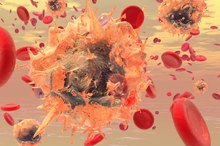Is Vitamin Deficiency the Cause of a Low White Blood Cell Count?
Vitamin deficiency is normally not the main cause of a low white blood cell count. Powerful infections such as AIDS or cancer are the main culprits. Having certain vitamin deficiencies can lower the white blood cell count a little and seriously impact the function of your white blood cells, making infections even more deadly. Understanding the vitamins that are important for maintaining white blood cell levels will help anyone suffering from a powerful infection remain as healthy as possible.
Vitamin C
Vitamin C stimulates production of white blood cells and improves function of white blood cells. When white blood cells release hypochlorous acid or bleach to kill infections, they can damage themselves in the process. The presence of vitamin C helps protect the white blood cells from damage, keeping more alive in the process.
Vitamin A
4 Common Vitamins to Help Increase White Blood Cells
Learn More
Vitamin A plays an integral role in the specialization of white blood cells. Without the presence of vitamin A, created white blood cells cannot be differentiated into the many different types of white blood cells, and that significantly reduces the functionality of white blood cells. As the body is attacked by infections and bacteria, the white blood cells shift into specialized forms to better defend against specific infections. By being able to differentiate white blood cells, the body can deal with the situation more efficiently.
- Vitamin A plays an integral role in the specialization of white blood cells.
- Without the presence of vitamin A, created white blood cells cannot be differentiated into the many different types of white blood cells, and that significantly reduces the functionality of white blood cells.
Understanding White Blood Cell Levels
To find out how many white blood cells are present in your body, health care professionals must draw some of your blood for a blood count test. From the test they can find out an approximate amount of white blood cells present in your body. The normal amount of white blood cells is 10,000, but there is no serious risk of infection until the count falls down to 1,000 or lower. Neutrophils, a specialized form of white blood cells, are the best at fighting infections. Typically half of your white blood cells are neutrophils but these levels can fall much lower than that in some instances without hurting the overall white blood cell count. By placing your blood under a microscope, health professionals can check the specialized white blood cell count.
- To find out how many white blood cells are present in your body, health care professionals must draw some of your blood for a blood count test.
Dangers of Low White Blood Cell Count
Vitamins That Work as Natural Antibiotic
Learn More
A low white blood cell count puts you at a huge risk of contracting infections since white blood cells play an important role in defending against invading viruses. After you acquire an infection, your body will have a harder time getting rid of it with a poor white blood cell count. If you have a low white blood cell count, it is important to take extra precautions to avoid getting sick. Avoiding food with bacteria, washing your hands frequently and protecting open wounds from bacteria are all great measures to reduce the risk of getting sick.
- A low white blood cell count puts you at a huge risk of contracting infections since white blood cells play an important role in defending against invading viruses.
- After you acquire an infection, your body will have a harder time getting rid of it with a poor white blood cell count.
Related Articles
References
- Linus Pauling Institute; Vitamin C; November 2009
- Linus Pauling Institute; Vitamin A; November 2007
- Ohio State University Medical Center: Low White Blood Count Precautions
- U.S. Library of Medicine. MedlinePlus. White Blood Cell Count. https://medlineplus.gov/ency/article/003643.htm
- Mayadas TN, Cullere X, Lowell CA. The multifaceted functions of neutrophils. Annu Rev Pathol. 2014;9:181-218. doi:10.1146/annurev-pathol-020712-164023
- Mcbrien CN, Menzies-gow A. The Biology of Eosinophils and Their Role in Asthma. Front Med (Lausanne). 2017;4:93. doi:10.3389/fmed.2017.00093
- Cromheecke JL, Nguyen KT, Huston DP. Emerging role of human basophil biology in health and disease. Curr Allergy Asthma Rep. 2014;14(1):408. doi:10.1007/s11882-013-0408-2
- Hoffman W, Lakkis FG, Chalasani G. B Cells, Antibodies, and More. Clin J Am Soc Nephrol. 2016;11(1):137-54. doi:10.2215/CJN.09430915
- Karlmark KR, Tacke F, Dunay IR. Monocytes in health and disease - Minireview. Eur J Microbiol Immunol (Bp). 2012;2(2):97-102. doi:10.1556/EuJMI.2.2012.2.1
- Görgens A, Radtke S, Horn PA, Giebel B. New relationships of human hematopoietic lineages facilitate detection of multipotent hematopoietic stem and progenitor cells. Cell Cycle. 2013;12(22):3478-82. doi:10.4161/cc.26900
- Hong JW, Noh JH, Kim DJ. Association between White Blood Cell Counts within Normal Range and Hemoglobin A1c in a Korean Population. Endocrinol Metab (Seoul). 2018;33(1):79-87. doi:10.3803/EnM.2018.33.1.79
- Riley LK, Rupert J. Evaluation of Patients with Leukocytosis. Am Fam Physician. 2015;92(11):1004-11.
- Flores-mireles AL, Walker JN, Caparon M, Hultgren SJ. Urinary tract infections: epidemiology, mechanisms of infection and treatment options. Nat Rev Microbiol. 2015;13(5):269-84. doi:10.1038/nrmicro3432
- Kasi PM, Grothey A. Chemotherapy-Induced Neutropenia as a Prognostic and Predictive Marker of Outcomes in Solid-Tumor Patients. Drugs. 2018;78(7):737-745. doi:10.1007/s40265-018-0909-3
- U.S. Library of Medicine. MedlinePlus. White Blood Cell Count.
Writer Bio
Based in New York, Judith Tompkins has been writing sleep and nutrition articles since 2002. She worked for six years as a polysomnographer and now serves as a nutrition consultant. Tompkins received an associate's degree in polysomnographic technology from Cuyahoga College, as well as a master's degree in applied clinical nutrition from New York Chiropractic College.









